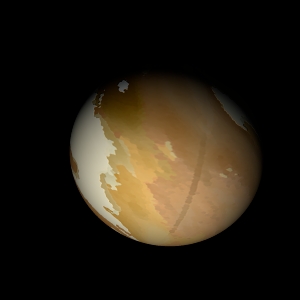|
|
Space Astro
|
Info for exoplanet "Yuan-z"
| Scientific (actual) data |
|---|
| Name | Kepler-1798 Ab |
| Planet status | Confirmed |
| Radius | 0.206006 |
| Orbital period | 16.8559 |
| Semi major axis | 0.1082 |
| Orbit eccentricity | 0 |
| Inclination | 89.96 |
| Discovered | 2017 |
| Updated | 2025-09-09 |
| Tzero tr | 2454970 |
| Impact parameter | 0.038 |
| Temperature (kelvin) | 408 |
| Publication | Announced on a website |
| Detection type | Primary Transit |
| Alternate names | KOI-2130 b, KOI-2130.01 |
| Star name | Kepler-1798 |
| Right ascension | 291.73° |
| Declination | 37.53° |
| Mag v | 16.391 |
| Mag i | 15.095 |
| Mag j | 13.594 |
| Mag h | 12.937 |
| Mag k | 12.776 |
| Star distance | 395.196 |
| Star metallicity | 0.104 |
| Star mass | 0.65 |
| Star radius | 0.641 |
| Star sp type | K7V |
| Star age | 13.9 |
| Star temperature | 3972 |
| Star alternate names | 2161536, KOI-2130 |
| Wikipedia article | Kepler-1798 Ab |
Back
| |
| Fictional info (?) |
|---|
| Suggested name | Yuan-z |
| Planet type | Planet |
| It may have had argon oceans in the past, but these would have vaporized as the temperature rose due to a runaway greenhouse effect. The argon has probably photodissociated, and the free carbon dioxide has been swept into interplanetary space by the solar wind because of the lack of a nitrogen layer. |
| Atmosphere | Carbon dioxide | 55% |
| Hydrogen peroxide | 27% |
| Argon | 8.3% |
| Nitrogen | 4.6% |
| Xenon | 3.4% |
| Helium | 1.2% |
| Water vapor | 0.0068% |
| Atmospheric pressure | 23 bar |
 |
| No known satellites |
| Google search for Yuan-z |
|
Website by Joachim Michaelis
|
|
|
|